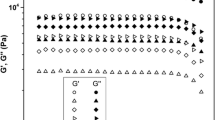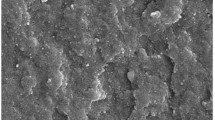Abstract
The miscibility of linear polypropylene (L-PP) and long-chain branched polypropylene (LCB-PP) blends was studied in relation to the rheological behavior in shearing and elongational deformations of the blends. The rheological properties of four commercial L-PPs with different molecular weights were studied by adding 10, 25, 50, and 75 wt% of LCB-PP to L-PP. The linear viscoelastic properties such as complex viscosity and weighted relaxation spectrum were determined as functions of LCB-PP content. According to the obtained rheological data, the LCB-PP showed a higher zero-shear viscosity and a longer relaxation time than the L-PPs. The linear viscoelastic properties showed an increase in the molecular weight and branched content of the L-PP with a reduction in miscibility. Furthermore, good predictions of linear viscoelastic properties for miscible and immiscible blends were achieved by applying the Palierne model. In uniaxial elongational tests, the L-PP showed no strain hardening behavior. By contrast, the addition of 10 wt% LCB-PP to L-PP resulted in strain hardening behavior at all strain rates. Hence, the strain hardening behavior of the blends was enhanced with LCB-PP content. The elongational viscosity data of the L-PP and LCB-PP and their blends were studied by employing the Molecular Stress Function (MSF) model which could predict the strain hardening behavior of the blends.









Similar content being viewed by others
Abbreviations
- \(G^{{\prime }}\) :
-
Elastic modulus
- \(G^{{\prime \prime }}\) :
-
Loss modulus
- \(G_{{}}^{*}\) :
-
Complex modulus
- \(\eta^{ + }\) :
-
Complex viscosity
- ω :
-
Frequency
- LCB-PP:
-
Long-chain branched polypropylene
- L-PP:
-
Linear polypropylene
- \(\eta_{0}\) :
-
Zero-shear viscosity
- \(H(\lambda )\) :
-
Continuous spectrum function
- \(g_{i}\) :
-
Relaxation modulus
- \(\lambda_{i}\) :
-
Relaxation time
- MSF:
-
Molecular Stress Function
- \(\phi_{\beta }\) :
-
Weightfraction of branched component
- \(\alpha\) :
-
Interfacial tension
- \(R_{v}\) :
-
Average radius of droplets
- \(a\) :
-
Diameter of tube segment
- \(\sigma (t)\) :
-
Extra stress tensor
- \(f\) :
-
Molecular Stress Function
- \(S_{\text{DE}}^{\text{IA}}\) :
-
Strain measure of the Doi-Edwards model
- \(S_{\text{DE}}\) :
-
Second-order orientation tensor
- \({\mathbf{u}}^{{\prime }}\) :
-
Unit vector
- \(u^{{\prime }}\) :
-
Length of unit vector
- \(\eta_{\text{E}}^{ + }\) :
-
Transient elongational viscosity
References
Palza H, Quijada R, Wilhelm M (2013) Effect of short-chain branching on the melt behavior of polypropylene under small-amplitude oscillatory shear conditions. Macromol Chem Phys 214:107–116
Gotsis AD, Zeevenhoven BLF, Tsenoglou C (2004) Effect of long branches on the rheology of polypropylene. J Rheol 48:895–914
Zulli F, Andreozzi L, Passaglia E, Augier S, Giordano M (2013) Rheology of long-chain branched polypropylene copolymers. J Appl Polym Sci 127:1423–1432
Nam GJ, Yoo JH, Lee JW (2005) Effect of long-chain branches of polypropylene on rheological properties and foam-extrusion performances. J Appl Polym Sci 96:1793–1800
Gotsis AD, Zeevenhoven BLF, Hogt AH (2004) The effect of long chain branching on the processability of polypropylene in thermoforming. Polym Eng Sci 44:973–982
Bailly M, Kontopoulou M (2009) Preparation and characterization of thermoplastic olefin/nanosilica composites using a silane-grafted polypropylene matrix. Polymer 50:2472–2480
Lee GW, Jagannathan S, Chae HG, Minus ML, Kumar S (2008) Carbon nanotube dispersion and exfoliation in polypropylene and structure and properties of the resulting composites. Polymer 49:1831–1840
Almeida LA, Marques MFV, Dahmouche K (2015) Synthesis of polypropylene/organoclay nanocomposites via in situ polymerization with improved thermal and dynamic-mechanical properties. J Nanosci Nanotechnol 15:2514–2522
Stange J, Uhl C, Münstedt H (2005) Rheological behavior of blends from a linear and a long-chain branched polypropylene. J Rheol 49:1059–1079
Li S, Xiao M, Wei D, Xiao H, Hu F, Zheng A (2009) The melt grafting preparation and rheological characterization of long chain branching polypropylene. Polymer 50:6121–6128
Borsig E, van Duin M, Gotsis AD, Picchioni F (2008) Long chain branching on linear polypropylene by solid state reactions. Eur Polym J 44:200–212
Krause B, Stephan M, Volkland S, Voigt D, Häußler L, Dorschner H (2006) Long-chain branching of polypropylene by electron-beam irradiation in the molten state. J Appl Polym Sci 99:260–265
Lugão AB, Otaguro H, Parra DF, Yoshiga A, Lima LFCP, Artel BWH, Liberman S (2007) Review on the production process and uses of controlled rheology polypropylene-gamma radiation versus electron beam processing. Radiat Phys Chem 76:1688–1690
Graebling D (2002) Synthesis of branched polypropylene by a reactive extrusion process. Macromolecules 35:4602–4610
Mogilicharla A, Majumdar S, Mitra K (2015) Multiobjective optimization of long-chain branched propylene polymerization. Polym Eng Sci 55:1067–1076
Auhl D, Stange J (2004) Long chain branched polypropylenes by electron beam irradiation and their rheological properties. Macromolecules 37:9465–9472
Guapacha J, Failla MD, Vallés EM, Quinzani LM (2014) Molecular, rheological, and thermal study of long-chain branched polypropylene obtained by esterification of anhydride grafted polypropylene. J Appl Polym Sci 131:40357–40369
Ahirwal D, Filipe S, Neuhaus I, Busch M, Schlatter G, Wilhelm M (2014) Large amplitude oscillatory shear and uniaxial extensional rheology of blends from linear and long-chain branched polyethylene and polypropylene. J Rheol 58:635–658
Hyun K, Ahn KH, Lee SJ, Sugimoto M, Koyama K (2006) Degree of branching of polypropylene measured from Fourier-transform rheology. Rheol Acta 46:123–129
Chikhalikar K, Banik S, Azad LB, Jadhav K, Mahajan S, Ahmad Z, Kulkarni S, Gupta S, Doshi P, Pol H, Lele A (2014) Extrusion film casting of long chain branched polypropylene. Polym Eng Sci. doi:10.1002/pen.24039
Spitael P, Macosko CW (2004) Strain hardening in polypropylenes and its role in extrusion foaming. Polym Eng Sci 44:2090–2100
McCallum TJ, Kontopoulou M, Park CB, Muliawan EB, Hatzikiriakos SG (2007) The rheological and physical properties of linear and branched polypropylene blends. Polym Eng Sci 47:1133–1140
Fang Y, Sadeghi F, Fleuret G, Carreau PJ (2008) Properties of blends of linear and branched polypropylenes in film blowing. Can J Chem Eng 86:6–14
Wagner MH, Kheirandish S, Stange J, Münstedt H (2006) Modeling elongational viscosity of blends of linear and long chain branched polypropylenes. Rheol Acta 46:211–221
Tabatabaei SH, Carreau PJ, Ajji A (2009) Rheological and thermal properties of blends of a long-chain branched polypropylene and different linear polypropylenes. Chem Eng Sci 64:4719–4731
Wang L, Wan D, Zhang Z, Liu F, Xing H, Wang Y, Tang T (2011) Synthesis and structure–property relationships of polypropylene-g-poly(ethylene-co-1-butene) graft copolymers with well-defined long chain branched molecular structures. Macromolecule 44:4167–4179
Wood-Adams PM, Dealy JM, deGroot AW, Redwine OD (2000) Effect of molecular structure on the linear viscoelastic behavior of polyethylene. Macromolecules 33:7489–7499
Honerkamp J, Weese J (1993) A nonlinear regularization method for the calculation of relaxation spectra. Rheol Acta 32:65–73
Utracki LA, Schlund B (1987) Linear low density polyethylenes and their blends: part 4 shear flow of LLDPE blends with LLDPE and LDPE. Polym Eng Sci 27:1512–1522
Palierne JF (1990) Linear rheology of viscoelastic emulsions with interfacial tension. Rheol Acta 29:204–214
Hussein IA, Williams MC (2001) Rheological study of the miscibility of LLDPE/LDPE blends and the influence of T mix. Polym Eng Sci 41:696–701
Ajili SH, Ebrahimi NG, Ansari M (2008) Rheological study of segmented polyurethane and polycaprolactone blends. Rheol Acta 47:81–87
Wagner MH, Rubio P, Bastian H (2001) The molecular stress function model for polydisperse polymer melts with dissipative convective constraint release. J Rheol 45:1387–1412
Abbasi M, Golshan Ebrahimi N, Nadali M, Khabazian Esfahani M (2012) Elongational viscosity of LDPE with various structures: employing a new evolution equation in MSF theory. Rheol Acta 51:163–177
Rolón-Garrido VH (2014) The molecular stress function (MSF) model in rheology. J Rheol 53:663–700
Wagner MH, Yamaguchi M, Takahashi M (2003) Quantitative assessment of strain hardening of low-density polyethylene melts by the molecular stress function model. J Rheol 47:779–793
Acknowledgments
We gratefully acknowledge Dr. SH. Tabatabaei for his valuable ideas throughout this paper.
Author information
Authors and Affiliations
Corresponding author
Rights and permissions
About this article
Cite this article
Maroufkhani, M., Golshan Ebrahimi, N. Melt rheology of linear and long-chain branched polypropylene blends. Iran Polym J 24, 715–724 (2015). https://doi.org/10.1007/s13726-015-0357-9
Received:
Accepted:
Published:
Issue Date:
DOI: https://doi.org/10.1007/s13726-015-0357-9




